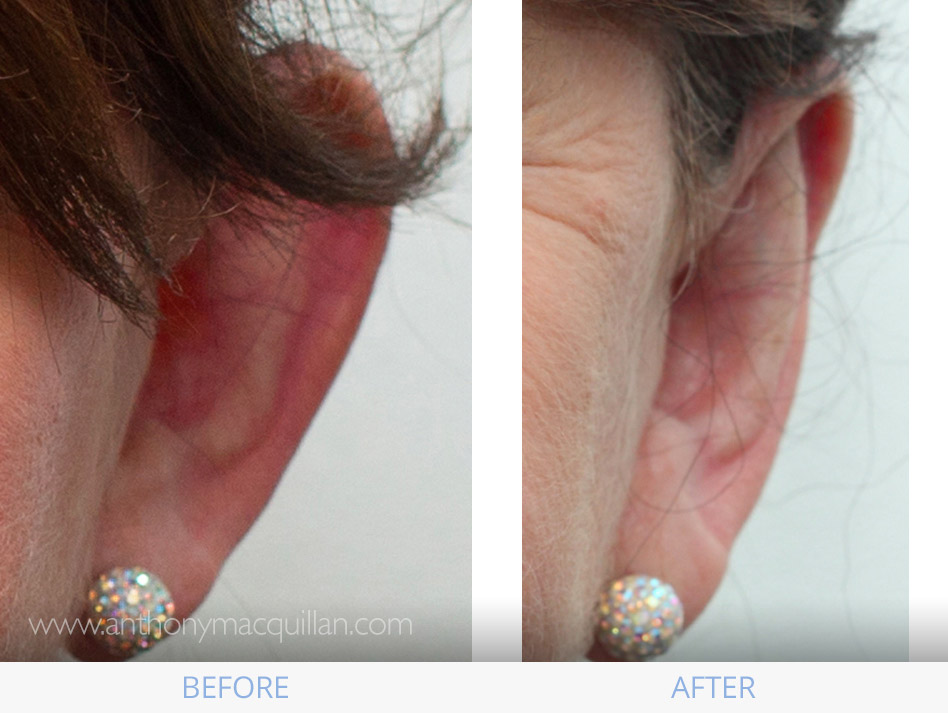Every surgical procedure involves a certain amount of risk and you must understand these risks and the possible complications associated with them. In addition, every procedure has limitations. An individual’s choice to undergo a surgical procedure is based on the comparison of the risk to the potential benefit. Although the majority of patients do not experience these complications, you should discuss each of them with Mr MacQuillan to make sure you understand all possible consequences of otoplasty surgery.

Asymmetry
Asymmetrical facial appearance may not result from otoplasty. Factors such as skin thickness, pre-existing cartilage shape, prominence, position and height on the side of the head may influence asymmetry in the ears. All patients have differences between the right and left side ear before any surgery is performed. Every effort will be made to achieve good symmetry after your surgery. However, there will inevitably be differences to each side and the potential for these differences must be accepted by you if you are undergoing otoplasty surgery.
Bleeding and Bruising
All patients get bruising of their skin and ears following otoplasty. This recovers over time but in some patients, this can last for many months. It is possible, though unusual, to experience a bleeding episode during or after surgery, should post-operative bleeding occur that does not stop, it may require emergency treatment. Do not take any aspirin or anti-inflammatory medications for ten days before surgery, as this may increase the risk of bleeding. Non-prescription “herbs” and dietary supplements can increase the risk of surgical bleeding. Haematoma can occur at any time following injury to the ears. If blood transfusions are needed to treat blood loss, there is a risk of blood-related infections such as hepatitis and the Human Immunodeficiency Virus (the virus that causes AIDS).
Infection
Rates of severe infection in otoplasty are low – quoted at around 2%. However, minor wound infections or inflammation may occur – if it does happen, an infection will be treated with antibiotics. Rarely, a return to the operating theatre to wash out the nose might be required. Catastrophic infection can result in the destruction of the ear cartilage framework and require formal ear reconstruction surgery.
Skin necrosis
Despite the skin being lifted off the underlying ear, the blood supply is usually very good, and the skin heals very well. Rarely, the blood supply to the skin of the ear is damaged during surgery, and areas of skin death can occur. Dressings may be required to speed up healing, and further surgery in the future may be needed should this happen.
Change in Skin Sensation
You may experience a diminished (or loss of) sensitivity of the ear and the skin which usually improves over time. Permanent loss of sensation can occur after otoplasty but is rare.
Damage to Deeper Structures
There is the potential for injury to deeper structures including, nerves, blood vessels, muscles, and cartilage during any surgical procedure. The potential for this to occur varies according to the type of procedure being performed. Injury to deeper structures may be temporary or permanent.
Delayed Healing
If an incision is made on the ear the wounds usually heal well. Rarely wound disruption, scar asymmetry or delayed wound healing can occur.
Scarring
All surgery leaves scars, some more visible than others. Although good wound healing after a surgical procedure is expected, abnormal scars may occur within the skin and deeper tissues. Scars may be unattractive and of a different colour to the surrounding skin tone. Scar appearance may also vary within the same scar. Scars may be asymmetrical (appear differently on the right and left sides of the body. There is the possibility of visible marks on the skin from sutures. In some cases, scars may require surgical revision or treatment. Scars can appear thick, red and raised all or part of the way along the incision line (a hypertrophic scar) or more rarely can involve tissues beyond the incision itself (and can resemble a badly healed burn), this is known as a keloid scar. Additionally, scars can tether to underlying structures or become abnormally pigmented. Additional treatments may be required for adverse scarring.
Swelling and Seroma
All patients get swelling after otoplasty. This improves with time but in some patients, this can take many months. Fluid accumulations infrequently occur in between the skin and the underlying tissues. Should this problem occur, it may require massage or steroid injections. Rarely there is permanent swelling of the ear leading to asymmetry.
Skin Contour Irregularities
Contour and shape irregularities may occur after otoplasty. Visible and palpable wrinkling may occur.
Skin Sensitivity
Itching, tenderness, or exaggerated responses to hot or cold temperatures may occur after surgery. Usually, this resolves during healing, but in rare situations, it may be chronic.
Surface changes
Contour irregularities in the skin may result after otoplasty and can be felt when the ear is touched. This may improve with time but some irregularities are permanent due to the nature of how cartilage heals. There is also scarring in the area, as with all forms of surgery, which is a normal response by the body to injury.
Pain
You will have pain following surgery. The intensity and duration of the pain varies from individual to individual following otoplasty surgery. Very infrequently chronic pain due to nerve damage or nerve entrapment in scar tissue may arise following face and neck lift surgery (neuropathic pain).
Sutures
Most operations involve the routine use of deeply placed sutures (stitches) within and beneath the skin. Such sutures are usually designed to dissolve however in some individuals they may take longer to dissolve than intended or may provoke a reaction from the body. In such instances, they may form small pockets of inflammation (stitch granulomas or abscesses) which resemble an infection but are in fact due to the underlying stitch. Similarly, the stitch may poke through the skin and become uncomfortable. In such cases, the stitches will require removal. If this occurs the new shape of the ear may be lost and further corrective surgery may be required.
Surgical plan
Although a pre-operative plan will have been discussed prior to the operation, there are multiple ways of undertaking an individual procedure. Each technique has been developed to achieve the same end result (though may result in differing scar patterns). It may sometimes be necessary to alter the initial plan discussed with you at the time of the operation due to anatomic considerations that become apparent during the course of the surgery.
Allergic Reactions
In rare cases, local allergies to tape, suture material, glues, blood products, topical preparations or injected agents have been reported. Serious systemic reactions including shock (anaphylaxis) may occur to drugs used during surgery and prescription medications. Allergic reactions may require additional treatment.
Deep Venous Thrombosis, Cardiac and Pulmonary Complications
Surgery, especially longer procedures, may be associated with the formation of, or increase in, blood clots in the venous system Pulmonary complications may occur secondarily to both blood clots (pulmonary emboli), fat deposits (fat emboli) or partial collapse of the lungs after general anaesthesia. Pulmonary and fat emboli can be life-threatening or fatal in some circumstances. Inactivity and other conditions may increase the incidence of blood clots travelling to the lungs causing a major blood clot that may result in death. It is important to discuss with your doctor any past history of blood clots or swollen legs that may contribute to this condition. Cardiac complications are a risk with any surgery and anaesthesia, even in patients without symptoms. If you experience shortness of breath, chest pains, or unusual heartbeats, seek medical attention immediately. Should any of these complications occur, you may require hospitalization and additional treatment.
Unsatisfactory Result
Although good results are expected, there is no guarantee or warranty expressed or implied, on the results that may be obtained. You will be disappointed to some extent with the results of otoplasty surgery. Asymmetry in the ears or unanticipated changes of shape and position may occur after surgery. As well as unsatisfactory surgical scar location, visible deformities, wound disruption, poor healing, loss of sensation and failure to achieve the aims may occur. It may be necessary to perform additional surgery to improve your results which is chargeable.
Further Reading about Face Surgery with Consultant Plastic Surgeon Anthony MacQuillan
- Read more about Eyelid Surgery
- Read more about Facelift Surgery
- Read more about Ear Correction Surgery
- Read more about Mid Facelift Surgery
- Read more about Neck Lift



